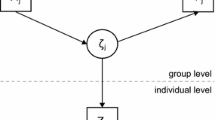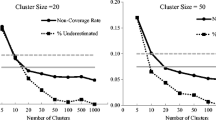Abstract
The multilevel approach can be a fruitful methodological framework in which to formulate the micro-macro relationships existing between individuals and their contexts. Usually, place of residence is taken as proxy for context. But individuals can be classified at the same level in more than one way. For example, not only may place of residence be relevant, but birthplace, household or working relations may also be taken into account. Contextual effects can be better identified if multiple classifications are simultaneously considered. in this sense, data do not have a purely hierarchical structure but a cross-classified one, and become very important to establish whether the resulting structure affects the covariance structure of data. In this paper, some critical issues arising from application of multilevel modelling are discussed, and multilevel cross-classified models are proposed as more flexible tools to study contextual effects. A multilevel cross-classified model is specified to evaluate simultaneously the effects of women's place of birth and women's current place of residence on the choice of bearing a second child by Italian women in the mid-1990s.
Similar content being viewed by others
References
Billari FC, Rohwer G (1999) Some developments in methods for life course analysis and their applications. XXXIX Riunione Scientifica della SIS,1, Istituto di Statistica e Matematica, Istituto Universitario Navale di Napoli
Bilsborrow RE, Guilkey DK (1987) Community and Institutional Influence on Fertility: Analytical Issues. Population and Labour Policies Programme. Working Paper no. 157, International Labour Office, Geneva
Browne WJ, Goldstein H, Rasbash J (2001) Multiple membership multiple classification (MMMC) models. Statistical Modelling1 1103–1124
Bryk AS, Raudenbush SW (1992) Hierarchical linear models: applications and data analysis methods. Sage Publications, Newbury Park
Casterline JB (1985) Community effects on fertility. In: The Collection and Analysis of Community Data (ed. Casterline JB), International Statistics Institute, Voorburg, Netherlands
Cotts Watkins S (1990) The transformation of demographic regimes in Western Europe, 1870–1960. Population and Development Review16, (2): 241–272
Courgeau D, Baccaini B (1998) Multilevel analysis in the social sciences. Population10, (1): 39–71
Degraff DS, Bilsborrow RE, Guilkey DK (1997) Community-level determinants of contraceptive use in the Philippines: a structural analysis. Demography34, (3): 385–398
De Sandre P, Ongaro F, Rettaroli R, Salvini S (1997) Matrimonio e figli: tra rinvio e rinuncia il Mulino, Bologna
Diamond I, Clements S, Stone N, Ingham R (1998) Spatial variations in teenage conceptions in South and West England. RSS Conference on Application of Random Effects/Multilevel Models to Categorical Data in Social Sciences and Medicine, London, 20 october
Entwisle B, Casterline JB, Sayed HA-A (1989) Villages as contexts for contraceptive behaviour in rural Egypt. American Sociological Review59, 1019–1034
Goldstein H (1995) Multilevel Statistical Models. second edition, Kendall's Library of Statiscs 3, Edward Arnold, London
Goldstein H, Rasbash J, Browne W, Woodhouse G (2000) Multilevel models for dynamic household structures. European Journal of Population16, 373–387
Goldstein H, Sammons P (1997) The Influence of Secondary and Junior Schools of Sixteen Year Examination Performance: A Cross-classified Multilevel Analysis. School Effectiveness and School Improvement8, (2): 219–230
Golini A (1999) Condizioni e fattori di contesto della fecondità italiana. In: Nuzialità e fecondità in trasformazione, (eds.) DeSandre P, Pinnelli A, Santini A, 511–520, il Mulino, Bologna
Gould M, Jones K, Moon G (1997) Guest Editorial: The scope of multilevel models. Environment and Planning A29, 581–584
Heath A, Yang M, Goldstein H (1996) Multilevel analysis of the changing relationship between class and party in Britain 1964–1992, Quality and Quantity30, 389–404
Hirschman C, Guest P (1990) Multilevel models of fertility determination in four Southeast Asian countries: 1970 and 1980. Demography27, (3): 369–396
Iversen G (1991) Contextual Analysis. Sage Publications, Newbury Park
Jones K, Duncan C (1996) Individuals and their ecologies: analysing the geography of chronic illness within a multilevel modelling framework. Health and Place1, 27–40
Kohler H-P (1997) Learning in social networks and contraceptive choices, Demography34, (3): 369–383
Kreft I, De Leeuw J (1998) Introducing Multilevel Modeling Sage Publications, London
Langford I (1996) A Cross-classified Multilevel Model of District Mortality Rates. Multilevel Modelling Newsletter6, (2): 9–11
Lazarsfeld PF, Menzel H (1961) On the relations between individual and collective properties. In: Complex Organizations (ed.) Etzioni, A. Holt, Rinehart & Winston, New York 422–440
Livi Bacci M (1977) A History of Italian fertility during the last two centuries. Princeton University Press, Princeton NJ
Longford NT (1993) Random Coefficient Models Clarendon Press, London
Mason W, Wong G, Entwisle B (1983) Contextual analysis through the multilevel linear model. Sociological Methodology 1983–1984, (ed.) Leinhardt S. 72–103 Jossey-Bass, San Francisco
Micheli GA (1987) Effetti contesto, effetti struttura nei differenziali territoriali del malessere demogravico. In: Atti del Convegno Informazione ed analisi statistica per aree regionali e subregionali Perugia: Galeno Editrice
Palloni AB (2000) Demographic analysis: new theories, new models, and new data. In: Demografia: presente e futuro. (eds.) DeSandre P, Ongaro F. 61–88, Cleup, Padova
Pickery J, Loosveldt G (2000) Modeling Interviewer Effects in Panel survey: An Application, Survey Methodology26, (2): 189–198
Rasbash J, Goldstein H (1994) Efficient Analysis of Mixed Hierarchical and Cross-Classified Random Structures Using a Multilevel Model. Journal of Educational and Behavioral Statistics19, (4): 337–350
Rasbash J, Browne W, Goldstein H, Yang M et al. (1999) A user's guide to Mlwin (Second Edition), Institute of Education, London
Rivellini G, Zaccarin S (1999) Comportamenti riproduttivi: biografie individuali e contesto in un'ottica multilevel, in Nuzialità e fecondità in trasformazione (eds.) DeSandre P, Pinnelli A, Santini A. 651–655, il Mulino, Bologna
Smith HL (1989) Integrating Theory and Research on the Institutional Determinants of Fertility. Demography2, 171–184
Snijders TAB, Bosker RB (1999) Introduction to Basic and Advanced Multilevel Modelling, Sage Publications, London
Steele F, Diamond J, Amin S (1996) Immunization uptake in Bangladesh. Journal of the Royal Statistical Society. Series A,159, (2): 289–299
Van Wissen L, Dykstra PA (edited by) (1999) Population Issues. An interdisiplinary Focus. 271–273, Plenum Press, New York
Wunsch G (1995) God has chosen to give the easy problems to the physicists or why demographers need theory. In: Evolution or Revolution in European Population. European Population Conference, 201–224, Franco Angeli, Milan
Author information
Authors and Affiliations
Rights and permissions
About this article
Cite this article
Zaccarin, S., Rivellini, G. Multilevel analysis in social research: An application of a cross-classified model. Statistical Methods & Applications 11, 95–108 (2002). https://doi.org/10.1007/BF02511448
Issue Date:
DOI: https://doi.org/10.1007/BF02511448




